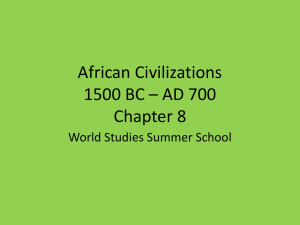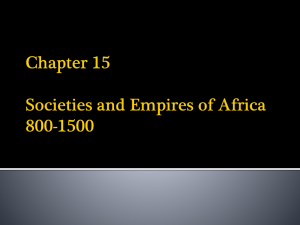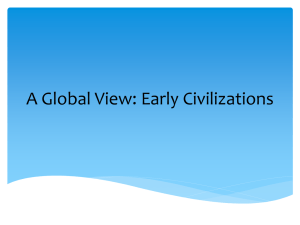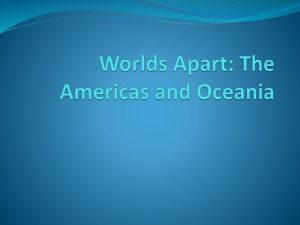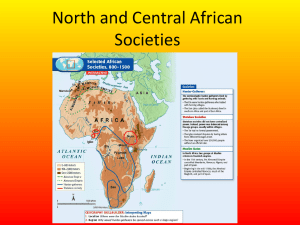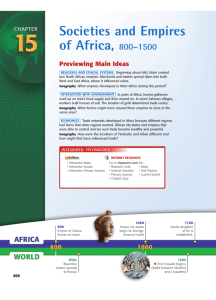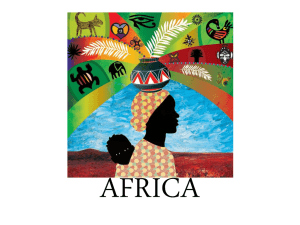Chapter 15 - Dublin City Schools
advertisement
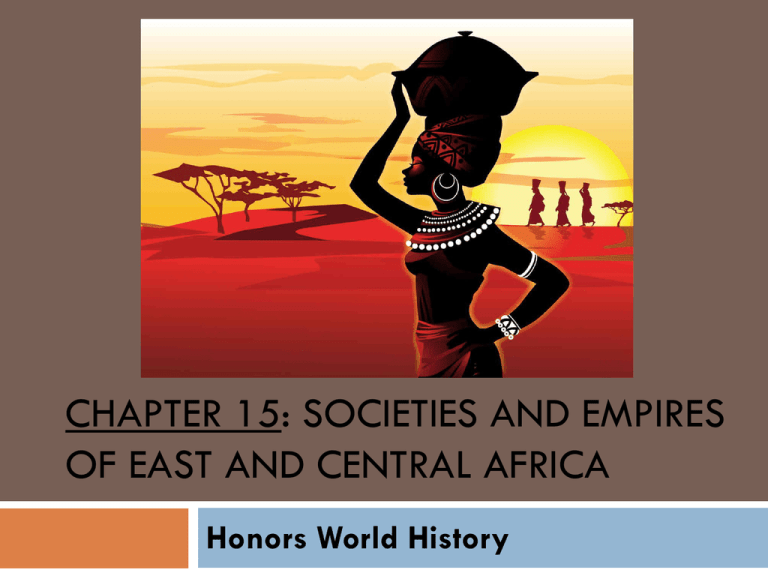
CHAPTER 15: SOCIETIES AND EMPIRES OF EAST AND CENTRAL AFRICA Honors World History Section 1: North & Central African Societies •Hunter-Gatherers •Stateless Societies •Muslim States Section 1: North & Central African Societies Hunting-gathering societies like the Efe of central Africa gathered wild food to survive. The Efe used informal mutually agreed-upon rules for sharing food and belongings. The structure of many African societies is based on extended families called “lineages” Section 1: North & Central African Societies In stateless societies, such as the Igbo, lineages shared power. The spread of Islam lead to the founding of Muslim states in North Africa Islamic law provided order and unified North Africa Two of the first Muslim states in North Africa were the Almoravid and Almohad empires. Section 1: Societies and Empires of Africa Summary of Section 1: Societies and empires in North and Central Africa had religious and ethical systems in place. This region developed hunting-gathering societies, stateless societies, and Muslim states. Section 1: North & Central African Societies Section 1:TASK Almoravid Almohad Both Section 2: West African Civilizations The main trans=Saharan trade items are gold and salt. Muslim merchants spread Islam to West Africa The Almoravids conquer Ghana, disrupting the goldsalt trade. Like Ghana, Mali, under the leadership of Sundiata, builds its wealth on the gold-salt trade Section 2: West African Civilizations Sundiata, Mali’s first great leader, conquered Ghana and made Niani its capital city and center of trade. King Mansa Musa creates an efficient government and expanded the Mali Empire. A devout Muslim, Musa went on a hajj to Mecca Upon his return he built several mosques in Timbuktu Timbuktu becomes one of the most important cities in the empire Section 2: West African Civilizations The writings of early Muslim historian, Ibn Battuta depicted what life in 14th century Mali was like. Mali began to decline in the 1400s The Empire of Songhi gained control of the trans-Saharan trade routes Emperor Sunni Ali expanded the empire through military conquest (He even conquered Timbuktu and Djenne’ Djaro and forced the queen to marry him). His son took over after he died Section 2: West African Civilizations Askia Muhammad stole the empire from Sunni Ali’s son. The Empire grew stronger under Askia’s leadership. He placed great emphasis on education and acquiring wealth. However, the empire lacked modern weapons (Chinese had gunpowder, Arabs had the crossbow, Moroccans had cannons) Section 2: West African Civilizations The Songhi Empire fell to the Moroccan army, which ended the period of West African empires. Other people in West Africa: - The Hausa people united by a common language and form of government (city-states ruled by local kings) - Each city-state was responsible for taking care of its own people (militarily, food, trade) Section 2: West African Civilizations Yoruba Kingdom: Its people also spoke a common language, had a city-state setup, lived as forest dwellers and mostly farmed. - Yorubian kings were considered divine - Ife and Oyo become the two largest Yoruba kingdoms - The Ife were gifted artists who carved in wood and ivory Another forest kingdom was Benin, whose rulers claimed descent from the first king of the lfe people. - Also had many gifted artists Section 2: West African Civilizations Summary of Section 2: West Africa contained several rich and powerful states including Ghana, Mali, and Songhi. These empires engaged in the gold-salt trade, had organized governments and many artists. This tells us today that these early civilizations had rich cultures before the Europeans came in and stole their history. Section 2: West African Civilizations Section 2 – Task:Create flash cards for these terms: 1) Ghana 3) Sundiata 5) Timbuktu 7) Songhi 9) Yoruba 2) Mali 4) Mansa Musa 6) Ibn Battuta 8) Hausa 10) Benin Section 3: Eastern City-States and Southern Empires East African seaports developed and became strong through trade with Asia Swahili became the universal trade language The city-state of Kilwa: Rich families had nice houses/furniture. Muslim women wore silk robes, gold and silver. Kilwa had control of the port city of Sofala which helped make the city-state rich through trade. Section 3: Eastern City-States and Southern Empires In 1488, the Portuguese, looking for a short route to India, sail around the southern tip of Africa and conquer Sofala, Kilwa, and Mombasa. This ends southeastern African control of the trade. Islamic influences increase as Muslim traders spread Islam to East Africa. East African rulers, officials, and native traders adopt Islam. Muslim traders begin the practice of exporting slaves from East Africa to Asia Section 3: Eastern City-States and Southern Empires The Great Zimbabwe, located in southeastern Africa was a great trading city established by the Shona people Most of the gold and ivory traded on the east coast of Africa came from the continent’s interior The Great Zimbabwe grew rich on controlling the gold trade to the coast, but mysteriously the city was abandoned The Mutapa Empire flourishes under the leadership of Mutota, but in the end the Portuguese overthrow Mutota and begin to politically control the region Section 3: Eastern City-States and Southern Empires Section 3: Summary: African city-states and empires gained wealth through developing and trading resources. The country of Zimbabwe, and the cities of Mogadishu and Mombasa have their roots in this time period. Also, it sets the stage for increasing European interference in Africa for centuries to come. Section 3: Eastern City-States and Southern Empires Section 3: Your Task: Answer question #’s 3, 4, & 5 on page 427. WRITE the question and the answer
